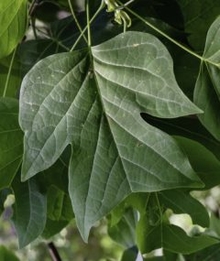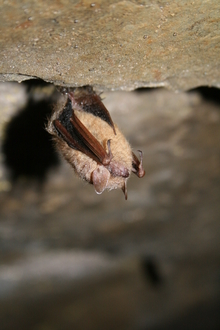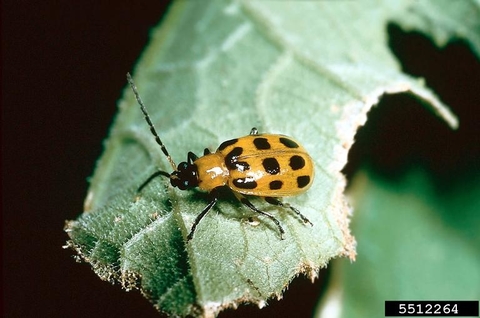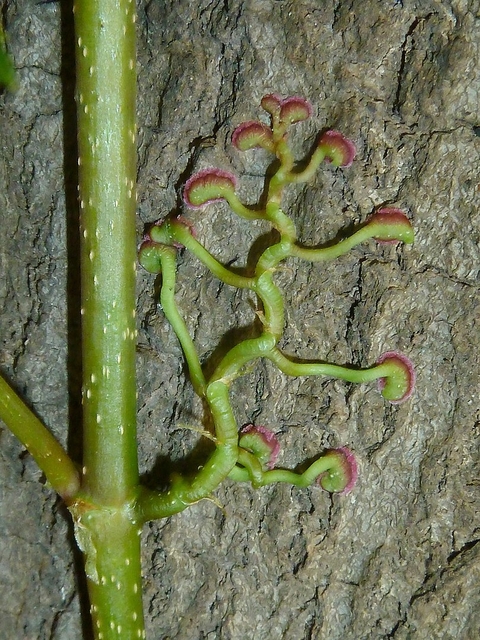The plant species in this spotlight are found in the list of Recommended trees and plants for the Rochester Plateau and Blufflands. That list includes one of my favorite childhood trees, the tulip tree. It also includes the Virginia creeper vine. This plant has amazing blood-red fall foliage and sticky, finger-like pads.
We’ll also learn about the spotted cucumber beetle, a native insect that's often considered an agricultural pest but plays a key role for some forest creatures.
Tulip tree or yellow poplar, Liriodendron tulipifera
Growing up in Indianapolis, there was a big yellow poplar outside our upstairs window. It produced large, pale yellow flowers shaped like tulips, and it was easy to snap one off to enjoy its sweet nectar. Also known as tulip tree, this species has unique shiny leaves in the shape of a cat’s face (or a two-dimensional tulip), making it very easy to identify.
Yellow poplar is a very important species in much of the eastern United States, covering an area from Florida to Illinois and north to central Michigan and upstate New York. It is very fast growing, and the wood is strong and straight so it’s also a valuable timber species. This tree is so beloved and of such high value that it is the state tree of Indiana, Kentucky and Tennessee.
It is the tallest tree in the eastern United States and can grow to 160 feet tall in its traditional range. The fruits are relatively small, windblown seeds, and it has beautiful yellow foliage in the fall. It is also the only Liriodendron native to North America, and its closest cousin the Chinese tulip tree.
Although this yellow poplar is new to Minnesota, species that use this tree in the forests of the eastern US have ranges that extend far into Minnesota. The nectar and pollen are used by various flies, beetles, bumblebees, honeybees, long-tongued bees and many other insects. The seeds feed cardinals, goldfinches, purple finches, gray, fox and red squirrels and several native mice. Yellow-bellied sapsuckers often drill holes to access the sap and then red-throated hummingbirds can access the sweet treat. Pileated woodpeckers also nest in these tall trees.
Tri-colored bat, Perimyotis subflavus
Another reason I chose to highlight yellow poplar is because female tri-colored bats create maternity colonies (groups of up to 30 individuals with offspring) in them. Tri-colored bats are the smallest bats in North America, typically weighing less than 8 grams, or about the weight of nine milk chocolate M&Ms.
Tri-colored bats get their names from the three distinct colors on their backs: dark gray at the base, yellow-brown in the middle and brown-red at the tip. Like all bats in Minnesota, tri-coloreds eat only insects. What’s on the other side of that food chain, you ask? In a ghoulish twist appropriate to the season, this tiny flying mammal is prey for the northern leopard frog, prairie voles, various birds of prey, snakes, skunks and raccoons.
As mentioned above, maternity colonies are in trees. Most females produce twin pups in June or July that together account for up to 58% of the mother’s postpartum weight. And here’s a wild fun fact: although adult bats mate in the fall, the sperm is held inside the female’s uterus until spring when the eggs are fertilized.
Adults hibernate individually, usually in mines, caves and other human structures common in southeastern Minnesota. Just like other hibernating bats, they are very impacted by the deadly white-nose syndrome and are on Minnesota’s species of Special Concern list.
Tri-colored bats are best left in the forest and fields because the rabies variants they carry are responsible for 70% of the human rabies cases from bats in the US. In addition, 75% of the cryptic rabies deaths in the US (cases without a clear origin or bite history) are from silver-haired and tri-colored bats, both native to Minnesota.
Spotted cucumber beetle, Diabrotica undecimpunctata
The spotted cucumber beetle is a bright yellow beetle with black spots. Also called the southern corn rootworm, the worm-like larvae hatch from eggs laid near grasses and corn in the southern US. The larvae feed on young plant roots including corn, but as it grows this insect becomes a plant generalist, feeding on many plants and plant parts throughout its life cycle. When the beetle matures and flies north they forage on the flowers, leaves, stems and fruit of many plants. In Minnesota, the spotted cucumber beetle feeds mostly on squash, pumpkins and cucumbers from June through August.
One species that’s recently been documented in Minnesota and is believed to be a case of natural range expansion (possibly due to climate change) is the evening bat, Nycticeius humeralis. This bat was found in southern Ramsey County in 2016, and folks in the Rochester Plateau and Blufflands region should be on the lookout for this new species. A bit of good news is that as our ecosystems shake-up, the new-to-Minnesota evening bat is a major consumer of spotted cucumber beetles. In southern Illinois spotted cucumber beetles make up almost 25% of the evening bat’s diet.
Virginia creeper, Parthenocissus quinquefolia
Virginia creeper, regardless of its name, is native to Minnesota and common in our woods. It can be easily confused with its close relation, woodbine, Parthenocissus vitacea; however, woodbine is a poor climber and tends to spread along the forest floor. Both are common in Minnesota, have huge native ranges throughout North America, and both are on our recommended plants list for Region 9.
Virginia creeper is a common plant in the oak-tulip tree forests of the eastern U.S., making it a good (planting) bedfellow of the aforementioned yellow poplar. Small purplish fruits are mature in the fall and are toxic to humans but are an important winter food source for birds. In the fall, its five-leaved, palmately compound foliage is a noticeable bright dark red color vining up trees and buildings. What a way to add some moody, seasonal atmosphere to a place.
The vine can be 70-100 feet long and uses small forked tendrils tipped with small adhesive pads to grip and scale trees and other structures. It is commonly sold as a horticultural plant in part because the sticky discs do not harm building masonry and can be used on walls as fast-growing shade. In 1981 it was listed as an invasive species in the United Kingdom in the Wildlife and Countryside Act. Invasive plants can scare the pants off of you, but there are no such concerns for this native plant in the U.S.
Tulip-tree: Illinois wildflowers, Wikipedia, New York Natural Heritage Program
Tri-colored bat: Wikipedia, MN’s LIst of Endangered, Threatened and Special Concern Species
Virginia creeper: Wikipedia
Spotted cucumber beetle: Wikipedia, UMN Extension, EPPO Global Database





